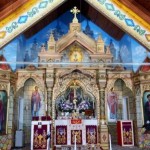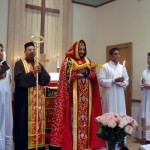Reading about this church council is interesting in itself, and can also teach us so much about the Orthodox understanding of the church and it’s attitude toward the material world.
During the reign of Emperor Leo the Third and his son Constantine of the Eastern Roman empire there was a campaign against icons on the part of these emperors. No one is quite sure why the emperors had started the campaign. After all, icons had been venerated in the church for many centuries. Indeed tradition tells us that St. Luke painted the first icon of the Mother of God. Some think the emperor’s order was based on the Old Testament commandment against the making of images of God.
Others think that influence of the anti-iconic Muslims who were threatening the empire influenced his decision. In any case, the emperor ordered icons to be removed from churches, public places and homes. Many Orthodox believers, clergy, monastics and laypeoples suffered in this campaign. The emperor even called a false council of bishops which condemned icons.
However, when Emperor Leo the IV died unexpectedly at a young age, his widow Empress Irene became regent for her young son. Irene believed in the veneration of icons and called another council which met in the year 787 and approved the use of icons. This council is the Seventh Ecumenical Council. Despite this council, the campaign against icons was renewed by Emperor Leon the V in 815 and wasn’t’ finally ended until another Empress, Theodora, acting as regent for her young son ordered the return of icons in 843. This event is commemorated as the Sunday of Orthodoxy during As interesting is this story is, what does it tell us about the church? First of all, no one bishop or group of bishops are “infallible”. In the history of the church there have been many false councils, including the one that condemned icons. Rather, the whole church has to receive the decision of a council. This can be a lengthy, cumbersome process, but it does work, because the Holy Spirit abides in and guides the church into the truth. Second, use of icons tells us something about the importance of the material world. In some religions and philosophies, the material world is seen as evil, or even as an illusion. In such a religion the goal is to be liberated from the material world.
However, in Christianity we believe that God created the world which is inherently good, despite the effects of sin on the world. This means that the goal of Christianity is the resurrection of the body in a transfigured heaven and earth. Because of this God uses material things (i.e., the water of baptism, the bread and wine of Holy Communion) in the process of human salvation. The veneration of icons is part of this. So we see that the Seventh Ecumenical Council has much to teach us not only about icons, but about the nature of the church and the church’s attitude toward the material world.
Troparion — Tone 8
Most glorious are You, O Christ our God! You have established the Holy Fathers as lights on the earth! Through them you have guided us to the true faith! O greatly Compassionate One, glory to You!
Kontakion — Tone 6
The Son who shone forth from the Father was ineffably born, two-fold in nature, of a woman. Having beheld Him, we do not deny the image of His form, but depict it piously and revere it faithfully. Thus, keeping the True Faith, the Church venerates the icon of Christ Incarnate.
Fr. John


 In what is known as the Age of Discovery (15th to 17th C) and afterward the nations of Europe brought the Gospel to many parts of Africa, Asia and South America and the church continues to grow in those places even today.
In what is known as the Age of Discovery (15th to 17th C) and afterward the nations of Europe brought the Gospel to many parts of Africa, Asia and South America and the church continues to grow in those places even today.